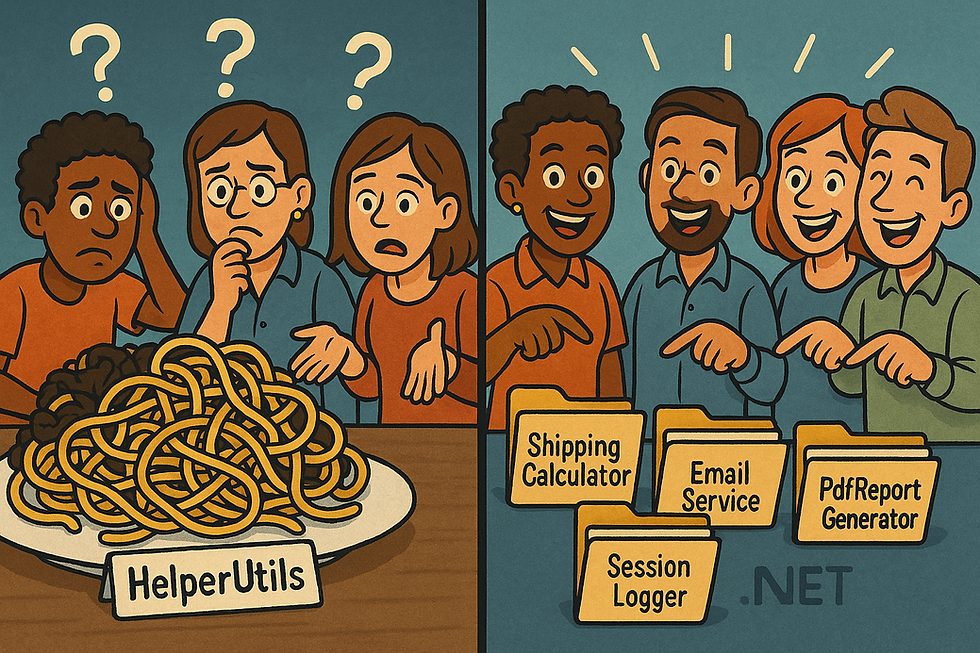“I” Is for Interface Overload: Why Your Classes Are Tired and Overcommitted
- Maryanne

- May 4
- 3 min read
The Interface Segregation Principle: Giving your software the freedom to say “no thanks” to extra responsibilities.
Somewhere out there is a C# interface named IAnimal with methods like Fly(), Swim(), ClimbTrees(), and MakeCoffee(). And yes, the poor Dog class that implements it is throwing exceptions left and right just to survive.
This is not what the Interface Segregation Principle had in mind.
The “I” in SOLID is all about respecting boundaries—specifically, making sure that no class is forced to implement methods it doesn’t actually need. Sounds simple, but in real-world codebases, especially legacy systems or overly eager frameworks, it’s one of the most abused principles in the book.
Let’s unpack why this matters, how to spot the bloat, and how to refactor your way back to sanity.

What Is the Interface Segregation Principle, Really?
The textbook definition:
Clients should not be forced to depend on interfaces they do not use.
Translated into real-life engineering speak:
Don’t make me implement junk I don’t care about just to make your interface happy.
When you violate ISP, you end up with classes that implement methods they never use. At best, they throw NotImplementedException. At worst, someone actually tries to use those methods and your app ends up doing something totally nonsensical.
The goal isn’t just to have smaller interfaces—it’s to create focused, meaningful contracts that don’t dump unnecessary baggage onto the classes that implement them.
The Classic Example (and Why It’s Still Relevant)
Let’s revisit the old IWorker interface:
public interface IWorker
{
void Work();
void Eat();
}Sure, sounds fine—until you try to implement it for a Robot.
public class Robot : IWorker
{
public void Work() { /* do robot work */ }
public void Eat() { throw new NotImplementedException(); }
}The Robot can’t eat. This is a violation of ISP. You’ve forced a class to accept an interface that doesn’t respect its limitations.
The fix? Split the interface:
public interface IWorkable
{
void Work();
}
public interface IFeedable
{
void Eat();
} Now Robot just implements IWorkable, and everyone’s happy. Especially the compiler.
Real-World Violations: Where This Shows Up in Actual Code
If you’re working in enterprise codebases—or heaven help you, something that’s been “evolving” since .NET Framework 2.0—you’ve likely seen ISP violations masquerading as “convenience” interfaces:
ISaveable with SaveToDatabase, SaveToFile, SaveToCloud(Your poor class just wants to write to a file. Why is it dealing with cloud credentials?)
IReportable with GeneratePdf, GenerateCsv, EmailReport, Print(Ever heard of composition, anyone?)
IDoEverythingBecauseWeDidn’tRefactor in years(No explanation needed.)
These interfaces grow like kudzu. One stakeholder asks for one more method, and boom, every class using it has to adjust. This is technical debt in the form of bad contracts.
How to Fix It Without Breaking the World
Refactoring interfaces in large systems is like changing the plumbing in a busy restaurant kitchen: risky, a little messy, and you need a plan.
Here’s what that plan looks like:
Audit the Interface UsageSearch across the codebase to see where the bloated interface is implemented and which methods are actually used by each class. This tells you what belongs where.
Break It Up Create smaller, purpose-driven interfaces. Think in verbs. One interface = one responsibility.
Apply Composition Instead of extending interfaces with more methods, compose functionality. Use multiple interfaces when needed, or even favor delegation over inheritance.
Use Adapter or Facade Patterns If Needed If you need to maintain backwards compatibility while refactoring, wrap the old interface and redirect to the new, smaller ones under the hood.
Resist the Urge to Please Everyone Not every method belongs in a shared interface. Sometimes you need different contracts for different consumers. That’s not duplication—it’s clarity.
But Wait—Aren’t “Fat Interfaces” Sometimes Okay?
Look, if you’re prototyping or hacking together something small? Sure. Go wild. But if you’re building something that’s meant to scale—or be touched by another human being later—you’re just piling on pain when you skip ISP.
When we ignore Interface Segregation, we’re basically saying:“Future-me can clean this up later.”Spoiler alert: future-you is busy fixing something else and resents past-you deeply.
Boundaries Are a Feature, Not a Limitation
A lot of engineering problems come down to boundaries. Misused interfaces blur those boundaries, make dependencies harder to manage, and turn simple changes into cross-cutting nightmares.
The Interface Segregation Principle is your way out. Small, focused interfaces let your classes do what they do best—and nothing more. You’re not being restrictive. You’re being respectful. Your codebase (and your team) will thank you.





Comments